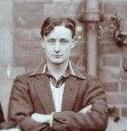
|
The King's School Canterbury |
Roll of Honour |
| Lieutenant Robert De Bedick SAUNDERSON | |
|
Gold Coast Regiment, West African Frontier Force Date of birth: 21st September 1891 Date of death: 18th October 1917 Killed in action aged 26 Buried at Dar Es Salaam War Cemetery Plot 6, Row F Grave 15 |

|
| He was born at New Ross, County Wexford in Ireland on the 21st of September 1891 the only son of the Reverend Robert De Bedick Saunderson MA, Vicar of Milton in Kent, and Frances Anna (nee Jones later Addison) later of Belmont College, Streatham Hill in London. He was educated at Chatham House School in Ramsgate, and at the King's School Canterbury from September 1906 to July 1910, where he earned his sports colours in 1910, before entering Keble College Oxford in October 1910 where he was a member of the Oxford University Officer Training Corps and was a member of the College Football XI in 1912 and 1913. He achieved a BA in 1913. On leaving university he became an Assistant Master at St Peter's Preparatory School, Seaford in 1914 and was appointed Assistant District Commissioner in the Gold Coast Service from January 1915. He served in Ashanti for a few months before he applied for secondment to the Gold Coast Regiment at Kumasi being accounted "one of the lucky ones" by his brother officers when his application was approved; he was granted the rank of Lieutenant. In November 1916 he returned from leave and served for a time in the Secretariat at Accra. In a letter home he said that he had been promised a permanent staff appointment. In April 1917 a draft of officers and men was required by the regiment and he joined them in the field in May when they were part of Kilwa Force and served with them, other than when he had a bout of sickness, until his death. On the 18th of October 1917 the Gold Coast Regiment found themselves facing enemy positions at Lukuledi Mission. Robert Saunderson was sent forward from the Pioneer Company to take over the section which at that time was being commanded by Sergeant Yessufu Mamprusi on the extreme left of the line. Very shortly after his arrival he led a desperate charge against the enemy position which was protected by a wall of thorns. His men loyally followed him, but the enemy fire was very heavy and Saunderson fell riddled with bullets within a yard of the impenetrable stockade of thorns. Sergeant Mamprusi, however, who had himself taken part in the charge, led the survivors back to their former position, where they stayed during the remainder of the afternoon. Mamprusi, who throughout showed great coolness and courage, and who continued to command his men to the end of the day was wounded in three places. Robert Saunderson's body was recovered and buried the next day, having been partially buried by the Germans during the night. Several of his section lay dead around him. His Commanding Officer wrote:- "He died leading his men in a most gallant charge against the enemy's entrenched position and was shot within a few feet of a thorn obstacle which the enemy had erected a few yards in front of his trenches. It was a most gallant action and if only your son had survived I would have brought his name before the GOC for a prompt reward for gallantry in the field.... Your son had endeared himself to us all by his bright and cheery disposition, and, in addition to the loss the regiment has sustained in so gallant an officer, we all mourn the loss of a friend." A brother officer wrote:- "It was a most gallant attempt and very nearly succeeded. Lieutenant Saunderson was killed during the charge, death being instantaneous. Owing to darkness and the presence of the enemy, it was impossible to recover the body of the late Lieutenant during the night of the 18th/19th of October. On the morning of the 19th it was discovered that the enemy had vacated their position. The body of the Lieutenant was found just outside the German position; it had been buried in a shallow grave by the Germans. The body was reburied in the consecrated grounds of the mission. The Church of England chaplain officiated at the burial service, a wooden cross bearing the deceased's name was put up at the grave." His body was later re-interred. He is commemorated on the war memorial at Keble College Oxford. |
|
Back